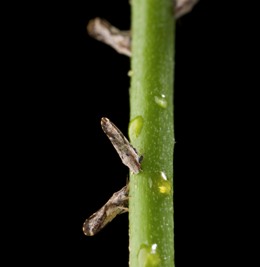The citrus greening disease, also known as “Huanglongbing” or HLB, is presently considered as the most serious disease affecting the U.S. citrus industry.
In 2005, it devastated the citrus industry of Florida, causing damage and lost revenue amounting to millions of dollars.
Diseased plants produce fruits that turn green after ripening.
It is believed that the causal organism is the bacterium Candidatus Liberibacter asiaticus.
A few years back, the Asian citrus psyllid (ACP) which transmits the disease has been found in Texas and California.
Texas is the third-largest producer of citrus fruits in the United States, mostly in the Rio Grande Valley.
The Valley produces grapefruit as its top citrus crop, with some orange, tangerine, tangelo, and Meyer lemon.
Responding to request for assistance by the Texas growers who fear a possible outbreak, scientists of the Agricultural Research Service of the U.S. Department of Agriculture (USDA-ARS) at the Kika de la Garza Subtropical Agricultural Research Center (SARC) in Weslaco, Texas, have embarked into accelerated research initiatives.
These scientists are now working in cooperation with federal and university personnel to develop a holistic strategy that can be applied to control infection and the spread of the disease.
The participation of neighboring countries like Mexico and other international partners is likewise deemed important because citrus is grown worldwide and thus the citrus greening disease is of worldwide concern.

Solutions to Control Citrus Greening
Despite the short time, the following research output were generated in the race for solutions to control citrus greening:
1. Entomologist Donald Thomas of the Crop Quality and Fruit Insects Research Unit (CQFIRU), leader of the area-wide project, found that increase in psyllid population occurs with new growth, called “flush,” which is favored by heavy rainfall and warm temperature.
Psyllids rely on flushing shoots for their reproduction and development.
2. Working with Mexican and U.S. federal cooperators, Thomas identified a tiny wasp named Tamarixia radiata as a potential biological control agent.
Other possibles are lacewings, beetles, spiders, and predatory mites.
3. In a related project, molecular biologist Jesse de Leon, with the Beneficial Insects Research Unit (BIRU), and colleagues from North and South America found two groups of Asian citrus psyllid, one prevalent in South America and the other in North America.
Through molecular testing, these two groups were found to be genetically distinct.
This suggests that each continent was invaded by psyllids from different Asian countries.
This finding further suggests that natural enemies of psyllids may have to be collected from different Asian countries.
4. Research is going on to find a material that will mimic the flushing shoots that attract the Asian citrus psyllid which uses sight and scent to find food.
This will be necessary for baiting and trapping.
Comparative studies conducted by Joseph Patt, also with the BIRU, under greenhouse conditions, revealed that more psyllids are attracted to cards colored yellowish-green scented with petitgrain oils than did unscented cards.
Petitgrain oils are essential oils from orange jessamine, an ornamental plant that is related to citrus, that is used as perfume bases.
5. A key to accelerated research to better understand the psyllid’s interaction with citrus plants is the forced flushing of the shoots so that year-round testing can be conducted.
This is important in order to find prompt solutions to prevent a citrus greening outbreak.
To this end, plant physiologist Nasir Malik succeeded in developing temperature-controlled growth chambers.
Grapefruit trees were placed in the growth chambers at temperatures of 4-8 C at night time and 18 C during the day for 2 weeks.
When the trees were transferred to the greenhouse where temperatures are warmer (26 C at night and 29 C during the day), they produced some flushes.
Longer treatments induced more flushing.
Trees that were placed in the growth chambers for 10 weeks flowered almost immediately when transferred to the greenhouse.
Malik also succeeded in inducing the production of new flushes in other trees including guava, pomegranate, and chapote (Casimiroa greggii).
6. Graduate student Deanna Chapa and cooperators from university, private industry, and government sectors compiled an online database of approved pesticides for the control of psyllid.
This is a convenient reference for citrus growers who are searching for effective pesticides that can be used to control the psyllids.
With the help of the ARS scientists, it is hoped that citrus greening outbreak can be prevented, either in Rio Grande Valley or elsewhere in the U.S.
The research outputs will likewise find application in other places worldwide where citrus is grown.
For now, the disease can be prevented by timely control of the Asian citrus psyllid.
REFERENCES
Yao, S. 2010. Citrus greening? Not if these scientists can help it! Agricultural Research. (November/December 2010). 58(10):4-7.
Wisler, G. 2010. Forum: working together to fight citrus greening. Agricultural Research. (November/December 2010). 58(10):2.
